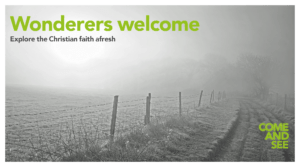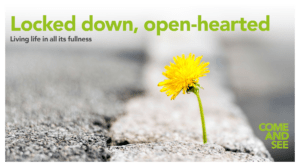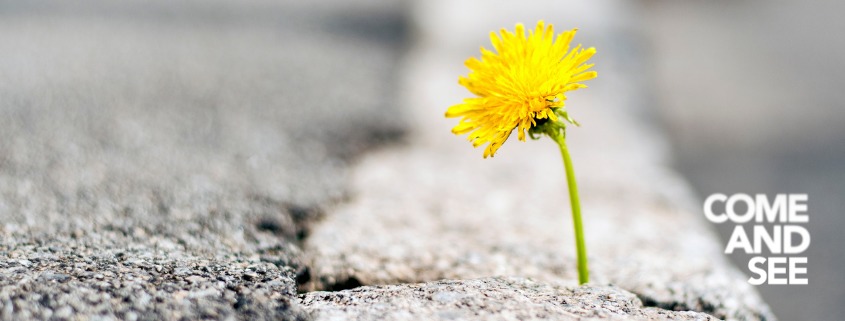Come and See was a big, warm, open invitation to everyone across the diocese to explore Christian faith in Lent this year. Bishop Steven looks back at the project and the lessons learned along the way.
What was Come and See?
Come and See was a big, warm, open invitation to everyone across the Diocese of Oxford to explore the Christian faith in Lent this year.
We used the four weeks before Lent as a season of invitation, using ecards and three personal testimony videos. We invited church leaders to sign up to receive support, encouragement and materials for the study course. We invited individuals to sign up first for daily emails and then indicate if they would like to contact a local church and join a small group. Lots of people took part – far more than I was expecting.
During Lent, we sent out a daily email to those who signed up for 40 days (click here for an example). The daily emails offered reflections on scripture based on the different elements in the Apostles’ Creed.
I recorded five 15-minute videos on the Apostles’ Creed for use in Lent. The films were for individuals, churches and as a guide for small group discussion. There were short leaders guides for each session and a handout, drawn from our Contemplative Toolkit, to help people encounter God through the sessions. You can find links to these resources at the bottom of this page.
Come and See was a big team effort: I led on teaching content, Tina Molyneux on project delivery and support, Charlie Kerr on the prayer exercises and Steven Buckley on project design and communications. But many others were involved, from parishes and deaneries, the area teams, Church House, and prayer support. Thanks to everyone who pulled together and helped Come and See to happen.
The context
 Come and See was and is part of our common vision as a diocese: we are seeking to be a more Christ-like Church for the sake of God’s world. One key strand in this is to invite other people to discover Christ and to help the whole church to be formed as disciples and live out our everyday faith.
Come and See was and is part of our common vision as a diocese: we are seeking to be a more Christ-like Church for the sake of God’s world. One key strand in this is to invite other people to discover Christ and to help the whole church to be formed as disciples and live out our everyday faith.
For some years, we have been trying to develop a simple pattern of Christian formation focused on the Church year: a season of invitation in Epiphany; an invitation to explore faith and go deeper in Lent; a season of deepening faith and sacramental life after Easter.
We’ve been learning how to support people’s everyday faith through simple one-to-one conversations and personal discipleship plans. All of that vision and learning fed into Come and See.
But the bigger context, of course, was the pandemic. People and churches needed support as worship, prayer, and learning had all moved online. There were signs that online worship was attracting a significant number of people who were not previously part of our congregations. How could we invite them to Come and See? How could we invite people to go deeper and learn more even during lockdown? And could all of us find the energy for this even in the midst of all that was happening?
I tested out the ideas for Come and See very tentatively in a series of online meetings in November, attended by around 400 people from across the diocese. Some were hesitant because of the wider context, but there was a great deal of support to take the idea further.
We did the initial design work in December, which felt very late and rushed, and launched the ideas across the diocese in three big webinars in January. The pandemic and the lockdown had both worsened by then. One half of my brain was telling me this was a crazy thing to do: a step too far. But the other was saying that we should at least offer this and see what happens. People were becoming aware of their deeper spiritual needs, inside and outside the church, because of all that was happening.
It seemed vital for the whole church to draw closer to Christ – to come and see – in the midst of so many challenges.
In every meeting to explore Come and See, we said, very deliberately, that this was an offer, something to explore, an invitation: no-one should feel any sense of obligation.
Who responded?
 Given all of this, the response to Come and See was amazing. More than 1,000 people subscribed to the daily emails, with an average open rate higher than for our other communications. Similar numbers of people watched the videos on the creed. 179 church leaders registered for the updates and further information.
Given all of this, the response to Come and See was amazing. More than 1,000 people subscribed to the daily emails, with an average open rate higher than for our other communications. Similar numbers of people watched the videos on the creed. 179 church leaders registered for the updates and further information.
The team have done a complete analysis of the statistics and the qualitative feedback. There were lots of really positive, appreciative comments about design and content (for which many thanks).
We don’t know, of course, and will never know, the full impact in peoples’ lives. But we do know that some people have come to faith and are moving on to baptism and confirmation.
We know that many more have been drawn deeper into their discipleship and have been more conscious of God’s grace during this very testing time.
We know that, for many local churches, lay and ordained ministers have been given the confidence to invite people in and to explore faith. We know that many of the participants have been offered one-to-one support and personal discipleship plans.
Read what Charlie had to say
Revd Charlie Kerr, Chaplaincy Advisor with ODBE, has been involved with school chaplaincy for nearly 15 years and says Come and See has been a great way to reconnect with students, both past and present, in an authentic and open setting.
“Whilst I am an ordained minister, I don’t have a church to run and therefore felt a strong desire to use Come and See to walk with people on their journey of faith. But the big question was, where to start?! Having been a school chaplain for many years, it seemed the right choice to use Come and See to support young people in their faith. Working with a student who I supported through confirmation, we reached out through our networks to see if there was an appetite for Come and See, and I am pleased to say there was! Using the group’s networks, we grew from three participants to nine, with ages ranging from early to late twenties.
“Although all were confirmed, what was interesting was that they were all at different stages when it came to their faith. We could easily break the group down into those who attended church regularly or felt they had a relationship with God, those who occasionally went to church and were interested in exploring their faith more deeply and those who, for some reason, had a more dormant faith. I think it is important to highlight these nuances, as it shows that Come and See really could be used by everyone – it wasn’t too ‘churchy’ or confusing, but it did satisfy those who had a stronger understanding of their faith and Christianity more widely, and it was wonderful to see conversations and discussions play out as a result of people’s different lived experiences of faith.
“For me, what was most powerful was the safe space that Come and See created. One of our group had had a fairly complicated relationship with her faith and, it is fair to say, was nervous about re-engaging with the Church. However, the fact that Come and See was the Church reaching out to her, in a setting that she felt comfortable in, with no hidden agenda, really helped her to feel supported in talking about her faith, sexuality and relationship with God.
“A key takeaway for me was how inspiring and engaging the group found Bishop Steven’s talks; he spoke from the heart, almost poetically, and he didn’t shirk away from thorny issues such as science and religion. Instead, he tackled them head on, in a way that was credible. Everyone felt his authenticity shone through and in actual fact, I will be using some of the content with Year 10 students from The Oxford Academy. It is rare to be able to share content with such a diverse group of people, but Bishop Steven has made it relevant and of interest to everyone, no matter their age, gender or background.”
Read what Toby had to say
Toby, team rector for the Benefice of Witney, used the benefice’s social media channels to promote several events they held in support of Come and See. They also held weekly bible study groups for people to come along to, which brought a number of people back to the church whose faith had perhaps lapsed. Toby says that those people in particular have been very positive about Come and See, saying that the content was not overwhelming or critical; instead it was welcoming and interesting.
As well as sessions for those who were re-engaging with their faith, Toby organised meetings for those who were new to faith or who had questions about Christianity. All were encouraged to sign up to the daily emails and to watch the videos.
“It was helpful to have a structure we could develop for our own situation and make our own, whilst using great resources that people could not only engage with in a formal setting but also more informally, if they wanted to continue their journey at home. People really appreciated the flexibility of the programme and its open and energising nature.”
What will happen to the materials?
It’s not too late to offer Come and See for churches that would like to do so. The five videos on the Apostles’ Creed and the guides and handouts remain available online, and the daily reflections are available in the Pilgrim Journeys booklet. Scroll down for links.
What did we learn?
There was a lot of learning for the team in the feedback. Especially around getting the pitch of the material just right, the value of engaging in this kind of adventure together, and the importance of starting earlier to build confidence and engagement.
What about next year?
We’ve listened carefully to the feedback and will do the learning. Our discernment is that it is right to offer Come and See to the diocese in a similar way in 2022. The theme for the daily reflections and Lent materials will be the Lord’s Prayer.
We will offer webinars in the early autumn to explore the ideas with parishes, so that local preparation can begin much earlier.
The Contemplative Toolkit remains in development as a parallel and longer-term project to be offered alongside other nurture materials. Piloting of that will begin this summer.
And finally…
Warm thanks to all who responded to the invitation to Come and See and everyone who contributed to the venture. It was great to be involved. In my own experience, every authentic invitation to share faith feels risky: you never know quite how people will respond and what will happen. But God is faithful, and there is indeed good fruit beyond our faith and expectations.
Please continue to pray for those journeying to faith and back to faith. We look forward together to seeing more of what God has done and more of what God will do as we continue to offer this big, warm, open invitation in the coming years.
+Steven
May 2021



